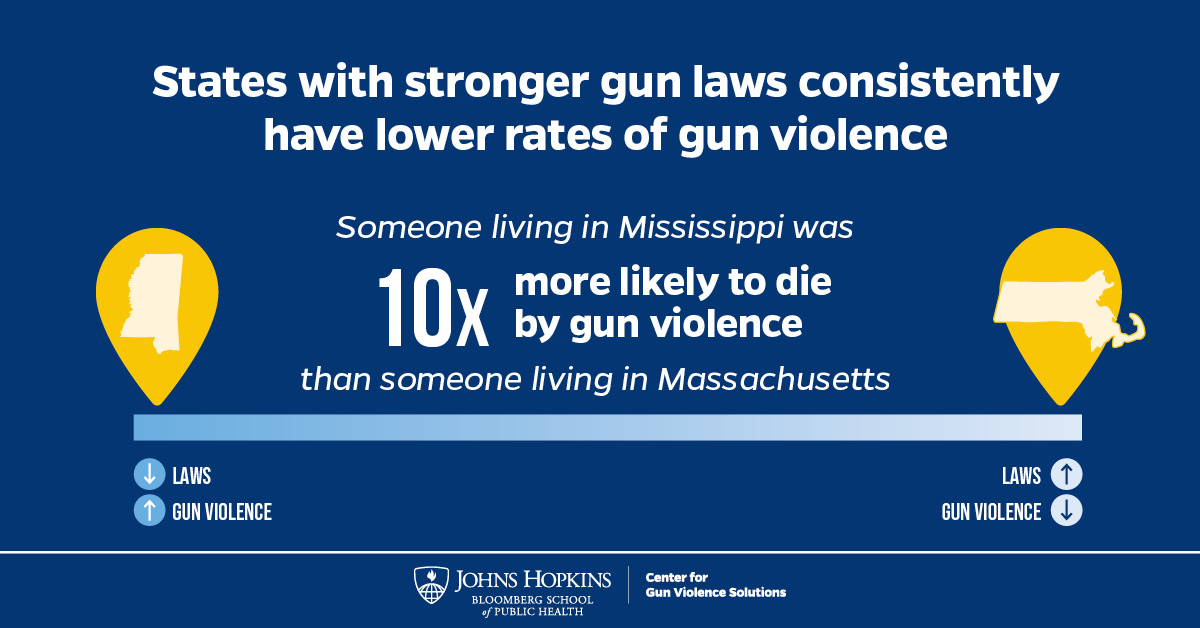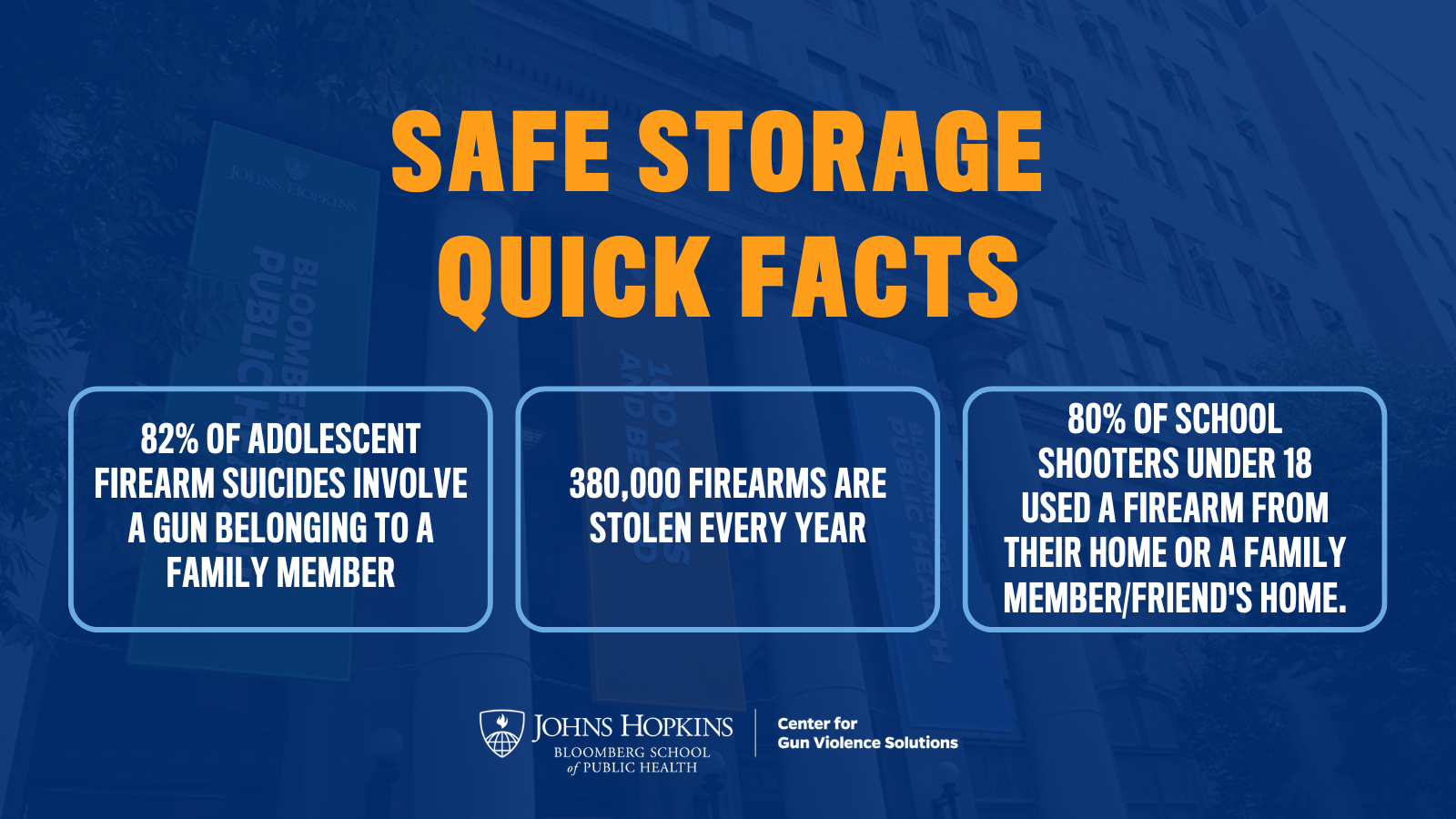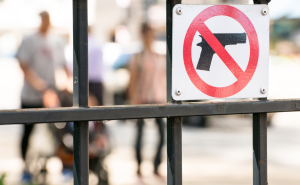A Bold New Goal: Reduce Gun Violence 30% by 2030

Bold New Goal: Reduce Gun Violence 30% by 2030
The Center for Gun Violence Solutions at the Johns Hopkins Bloomberg School of Public Health has a bold new goal to reduce gun violence 30% by 2030. In 2022, more than 48,000 people died by firearms in the United States, a 30% reduction would mean 14,400 lives saved. To reach this important goal, the Center will work with states and localities to implement five priority solutions that reduce gun violence.
These solutions are:
- Firearm Purchaser Licensing
- Safe and secure gun storage
- Firearm removal laws such as Extreme Risk Protection Orders (also known as “red flag laws”)
- Community violence intervention
- Regulating the public carry of firearms
Research shows that not only do these five solutions save lives but they are broadly supported by Americans across the political spectrum and with gun owners and non-gun owners alike. While there will be challenges ahead in making this goal a reality, the Center’s team is committed to advancing these research-based gun policies in order to save lives nationwide.
“We have witnessed unprecedented momentum at the state level in the last couple of years and now is the time to focus on those efforts that can truly save lives.” says Joshua Horwitz, JD, co-director of the Center for Gun Violence Solutions. “I am optimistic that we can get this done."

These 5 Save Lives
The Center urges policymakers to pass this suite of firearm regulations to save lives and effectively combat the public health epidemic of gun violence.
"Our policy priorities are associated with significant drops in gun violence,” says Cass Crifasi, PhD ’14, MPH, co-director of the Center for Gun Violence Solutions. "These solutions take a public health approach, backed by research, that focuses on both firearm access and underlying risk factors that contribute to gun violence.”
The policies are further outlined below.
Firearm Purchaser Licensing
Effective gun violence prevention starts with Firearm Purchaser Licensing, also known as permit-to-purchase. Research shows this policy is associated with reductions in firearms trafficking and multiple forms of violence. Firearm Purchaser Licensing requires a person to get a permit/license before buying a firearm. The policy addresses gaps in federal law by including an enhanced background check, safety training, and a waiting period while the application is processed.
State success stories offer a glimpse into what a nationwide strategy to implement these policies at the state-level could accomplish. Research shows Connecticut’s 1995 Handgun Licensing law was associated with a 28% reduction in the state’s firearm homicide rate and a 33% reduction in the state’s firearm suicide rate from 1996 to 2017.
On the other hand, Missouri repealed its Handgun Licensing in 2007. This repeal was associated with a 25% increase in the annual firearm homicide rate during the first three years after the repeal and a 16% increase in the firearm suicide rate during the five years after the repeal.
Firearm Purchaser Licensing is also extremely popular. A 2023 nationally representative survey from our Center showed 72% of respondents support requiring a person to obtain a license before buying a gun. 64% of gun owners agree.
As of May 2024, 11 states and Washington, D.C. have a Firearm Purchaser Licensing law on the books. Delaware is the latest state to pass a Handgun Purchaser Licensing law after Governor John Carney signed the bill into law on May 16. The Center worked for years with grassroots groups including the Coalition for a Safer Delaware to support the passage of the policy.
72% of Americans support requiring a person to obtain a license before buying a gun.
64% of gun owners support requiring a person to obtain a license before buying a gun
Firearm Removal Laws
Firearm removal laws include two categories of risk-based firearm prohibitions: Extreme Risk Protection Orders and Domestic Violence Protection Orders. These laws are in place to prevent people at high risk of harm to self or others from owning or purchasing firearms. The policies use history and threats of violence to indicate when the justice system needs to become involved.
Extreme Risk Protection Orders (ERPO), also known as “red flag laws,” are civil court orders that temporarily restrict firearm access for those at high risk. Law enforcement, and, depending on the state’s ERPO law, others such as family or household members, may petition the court to temporarily restrict a person’s access to firearms when they are at elevated risk of harming themselves or others. ERPO laws include due process protections including notice, court hearing, and penalties for abuse of the program.
Evidence shows “red flag laws” effectively reduce firearm suicides and homicides. In a study of 762 ERPO-style orders in Connecticut, researchers calculated that for every 10-20 orders issued, one suicide was prevented. In a separate analysis of a 6,800 orders from six states (CA, CO, CT, FL, MD, WA), researchers found 10% of ERPOs were issued in response to a threat of mass violence.
Passing these laws is the first step. Implementing them is equally as important to reduce gun violence 30% by 2030. In 2023, the Center for Gun Violence Solutions worked with the Department of Justice to launch the National ERPO Resource Center. Center experts offer training and technical assistance to implementers across the country in states that already have passed ERPO laws.
Domestic Violence Protection Orders (DVPOs), go hand-in-hand with “red flag laws.” These laws have been in place for decades to disarm those with a history of domestic violence and who are at the highest risk of causing harm to others. This policy is a key step in protecting some of those most vulnerable to gun violence. Evidence shows nearly half of all women murdered in the United States are killed by a current or former romantic partner. More than half of those homicides are by firearm.
Domestic violence can also indicate a risk for mass violence. Researchers have found that perpetrators of 68.2% of mass shootings from 2014-2019 either killed family or intimate partners or had a history of domestic violence.
Safe and Secure Gun Storage

Gun owners are responsible for keeping their firearms out of the wrong hands. Evidence indicates 380,000 guns are stolen every year. Many of those firearms lead to injury and suicide. An estimated 82% of adolescent firearm suicides involve a gun belonging to a family member. 80% of school shooters under 18 years old used a firearm from their own home or the home of a family member or friend.
Safe and secure gun storage laws require owners to lock firearms when not being used. Strong policies require firearms to be stored locked, unloaded and separate from ammunition. Certain laws focus specifically on children, Child Access Prevention laws create criminal penalties for unresponsible firearm storage that leads to a child gaining access to the firearm. Multiple studies have shown Child Access Prevention laws lead to statistically significant reductions in teen firearm suicides and unintentional injuries among children.
Regulating Public Carry of Firearms
The research is clear – the higher rate of firearm ownership, the higher risk of firearm violence. When people are allowed to bring firearms in public with permissive concealed carry laws, violence rates increase. Over the past 40+ years, many states have moved in the wrong direction – making it easier to carry a firearm in public without a license. Various studies have found weakened concealed carry policies are associated with higher rates of overall firearm assaults, violent crime, shootings by police and rates of firearm homicide in the workplace.
To create an equitable and effective solution, states and municipalities should pass laws prohibiting open carry of firearms entirely. Furthermore, states should strongly regulate concealed carry of firearms by requiring a rigorous permitting process. This includes mandatory live firearm safety training and a ban on those with violent misdemeanors from obtaining a concealed carry license. Additionally, states should prohibit concealed carry in sensitive places like government buildings, polling places and protests.
Community Violence Intervention
The Center understands that gun violence disproportionately affects certain communities, especially Black Americans. As a whole, Black Americans suffer from a 14 times higher gun homicide rate than their white peers. Community Violence Interventions can help reduce this problem.
The Center recommends two types of programs. Violence interruption programs use credible members of the community who are trained to help interrupt the cycle of violence. They help connect people who are at the highest risk of causing and being victimized by gun violence to social services. Similarly, Violence Reduction Councils are cooperative groups of law enforcement, community members, and service providers who analyze firearm violence in their city. The group identifies gaps in the system and opportunities to intervene. After their examination, the council develops policy recommendations to improve how the city addresses the underlying risk factors for violence.
Improving a community’s environment can also lower risk factors. Research shows that reducing blighted lots, alcohol outlets, and vacant buildings can also reduce gun violence in a community. Better street lighting and community gardens can also make a big difference.
The Way Forward
The Johns Hopkins Center for Gun Violence Solutions is charting a transformative path to reduce gun violence by 30% by 2030. Through a rigorous, evidence-based public health approach, the Center is spearheading key initiatives such as Firearm Purchaser Licensing, Extreme Risk Protection Orders, Domestic Violence Protection Orders, safe storage laws, public carry laws, and Community Violence Intervention. These measures are supported by research and data demonstrating their efficacy in saving lives. The Center’s goal also emphasizes the importance of addressing underlying risk factors and community-specific interventions to create safer environments.
As the Center continues to collaborate with policymakers, law enforcement, and community organizations, it remains committed to driving meaningful change through advocacy efforts and implementing effective solutions nationwide. By treating gun violence as a public health emergency, we hope to create a safer future for all people in the United States.




